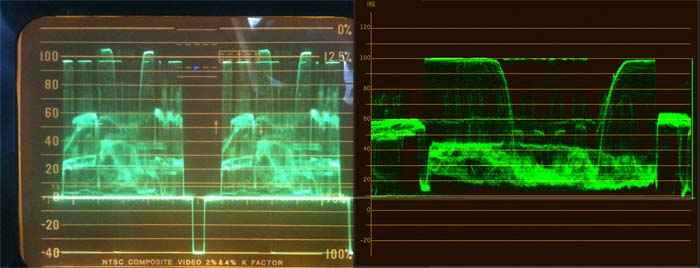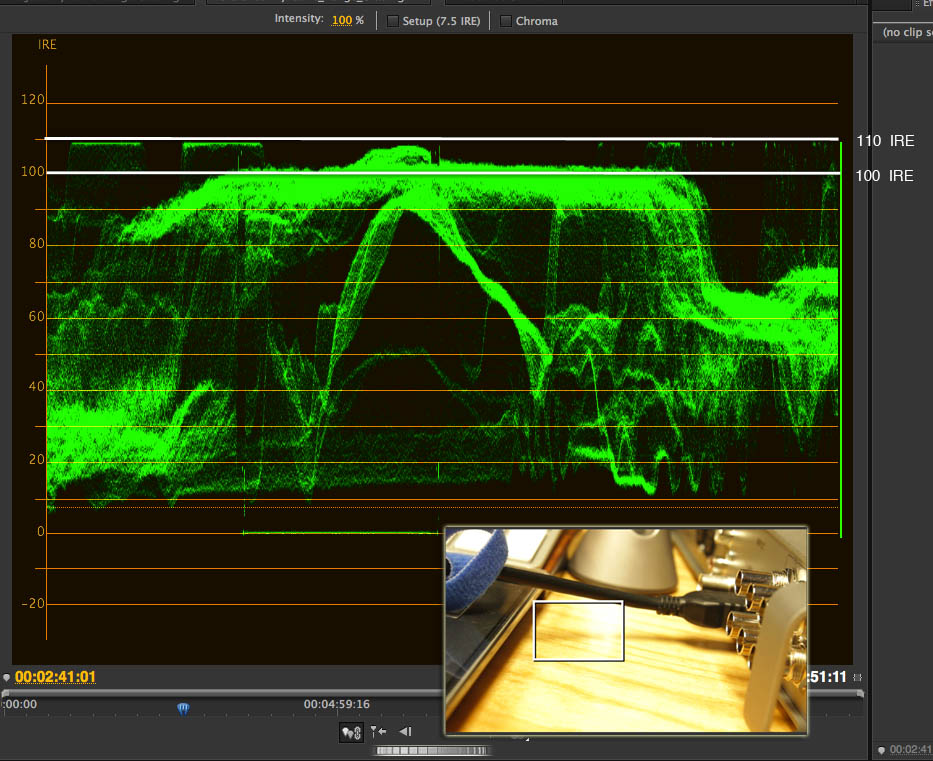60D Dynamic Range : Part 2, 3 and 4 Combined : Why you Should NOT Shoot Flat On a DSLR With An 8 Bit Codec
What started out as a simple question has become a more complicated answer. There are a lot of people out there saying “Just Shoot Flat” on the web. In what is now the first part of this series of tests, I’ll say yes. In high contrast situations like snow in sunlight, by all means turn down the contrast control. In taking a look at the 60D’s dynamic range I had a question thrown at me – am I looking at a NLE / software scope or hardware scope in judging whats going on ? I have both so I put them to the test.
Let me explain and show you something interesting. In the first part I talked about if 100 IRE = 235 or 255. On the scopes in my NLE, the codec was clearly clipping at 100 IRE, there was nothing above. If I plug the 60D’s composite out into my Tektronix scope there is a surprise, over brights ! In the image below you can see that I’ve got whites hitting about 105 IRE. I could not get anything hotter then that from the camera. The flat top areas at about 97 IRE are in fact the onscreen text overlays. So in response to the poster, yes the camera puts out hotter then 100 IRE on its video outs, but the codec which you actually record to ins’t giving it to you. In a word, that sucks, Canon, H264 has more to offer then what you have limited us to. Let us have everything the spec can handle : 10 bit 4:2:2 or 4:4:4.
Part 3
Good science means you can repeat the results. Today I ran the HDMI out of my 60D into a MXO2 and used Matrox’s Vetura capture software to grab the video output to ProRes 1080. That worked as expected and I grabbed a short clip, opening and closing the iris to get a range of exposure values. The shot was nothing special, just the MXO2 sitting on my desk.
In this shot which looks about right for exposure the scopes show something very interesting, I’ve got whites at 109 IRE! However, the clip from the camera is only 100 IRE, hard clipped.
With this info in hand, I’m going to try to dig up a chip chart and run some tests to see if the camera is compressing its hot signal down to 100 IRE compressing the range, but still retaining highlights values, or if the codec is simply hard clipping everything over 100 IRE out. If the codec is hard clipping information, that means using the camera’s video out for monitoring even with a scope is not accurate. You can see it on the monitor, but not record it to the card. This would be seriously troubling if it proves to be the case which I am suspecting will be true.
Part 4
What started out as a pretty simple series of tests got a lot more complicated. I completed another round of tests using a simple chip chart. Now I need to make one disclaimer here, the chip chart I got my hands on was not a great one. It wasn’t one of those expensive official 10 stop charts, but rather a printed one that came with an old copy of On Location. Before you all get excited about this, please consider what I needed for these tests : a way to generate some cleanly stepped values for highlights. In this purpose you’ll see the chart did just fine. It also let me look at some other more interesting things that the camera is doing, especially comparing the output of the hardware scopes to what the codec records.
A big question here is, what happens when video out is over 100 IRE – is the codec clipping ? Initial tests indicated it was, but in this series of images, it appears that the camera is actually processing the image data down to generally fit into the range of 0-235 / 100 IRE max. It seems to be compressing the top end down to preserve whats in the image.
This does however bring up more problems : the camera’s video out is not an absolutely accurate way of knowing whats really being recorded ! This completely and totally flies against everything any video camera has ever done. What comes out of video out should be exactly the same as what is recorded ! Now while it appears that the camera is in fact preserving all the image data you see on video out, it means that any sort of monitoring from the camera is simply inaccurate. You can not use scopes to setup the camera, or to try to match them the way you would a conventional video camera. This even means that an expensive several thousand dollar video monitor is something of waste as it may not show you anything more then what a cheap one will. The fact is, a monitor introduces its own variables in terms of what it displays and how. It makes the me almost want the days of NTSC back where everything was far more standardized, repeatable and reliable. It seems in the era of new cheap HD digital everything, standards are out the window unless you want to spend serious money.
Each of the following images can be clicked on to see a full size image.
Take a look at how the camera sends out video, compared to how it records it. The first thing I want to say is, I’m shooting “flat” as per internet buzz about how you are supposed to shoot to get the most dynamic range from the camera.
In the very first screen shot, its clear that with contrast at min, the blacks are really elevated. Guess what ? I almost succeeded in getting 7 bits worth of gray value ! If you see my whites are at 90 IRE while my blacks are at 30 IRE, thats just 60 IRE worth of range, a 40% reduction of what just plain old composite video can carry, never mind our digital video formats.
Next I cranked up the exposure to see what is really going on with highlights. While the hardware scope shows a little small difference, back in the digital world two things have happened :
1. The over bright whites have been pushed down to 100 IRE.
2. The rest of the signal has also been compressed !
This means that no image data visible on video out has been per se lost, but is has been compressed down to less dynamic / bit range by the codec. I”m not saying this is so much bad, but not what any one expected.
Another exposure variation, not nearly as over exposed with distinct steps in the overbright area. The codec has safely brought them back into “legal” range. However, with contrast on min, black levels are at about 50%. Hey I may of just made 7 bit images with 8 bits to play with.
Another shot where I just cranked up the exposure, but still the codec has compressed the highlights.
Here I dialed the contrast back to mid level. I have shades that are starting to look like black. They are still too hot, but I’m getting better.
Finally I turned the contrast all the way UP ! I finally have real blacks, and I’m making the most of the color space. If you are shooting a flat scene, increasing contrast can well be a good thing. Yes this completely go against what some folks have been saying, which is to just shoot with reduced contrast all the time making for a “raw” style image. This isn’t RAW, not by any means. Creating images that look like them, but are actually only holding 7 bits of color vs RAW”s 12 is just wrong.
Same exposure, but contrast set to min, I have again reduced the usable range of gradation.
So what does this mean ? it comes back to what the old school camera guys have said all along “Get it right in camera ! ” Seriously, reducing contrast and shooting flat buys you nothing except less gradation and less dynamic range in the recorded image. Sure you can color correct the image back so that blacks are black, whites are white, but with a lot of missing image data when doing so. What shooting flat does do is buy you some fudge factor – its less likely to under expose or over expose your image. Sure that works when you really have no idea how the camera handles and you have no idea where your monitor is in terms of telling you what you are getting. That doesn’t get yo the best image you can get recorded though.
Use the histograms if your camera has them. While you can’t totally trust them, they will let you know you are spreading out your exposure enough to make a gradable image in post that won’t cause too much cussing ! You’ll know if you are too dark or brite because of how it bunches up. Likewise, even if the histogram looks a bit hot, as long as it isn’t completely blown out the codec will squeeze it back into legal video range, even if you aren’t going to broadcast with it.
I hope this has gotten all of you thinking that you need to use your eyes, histogram and some experience to get the best image. Shooting flat isn’t the answer, its part of the problem and if you want to be a DP you need to learn your tool and medium.








